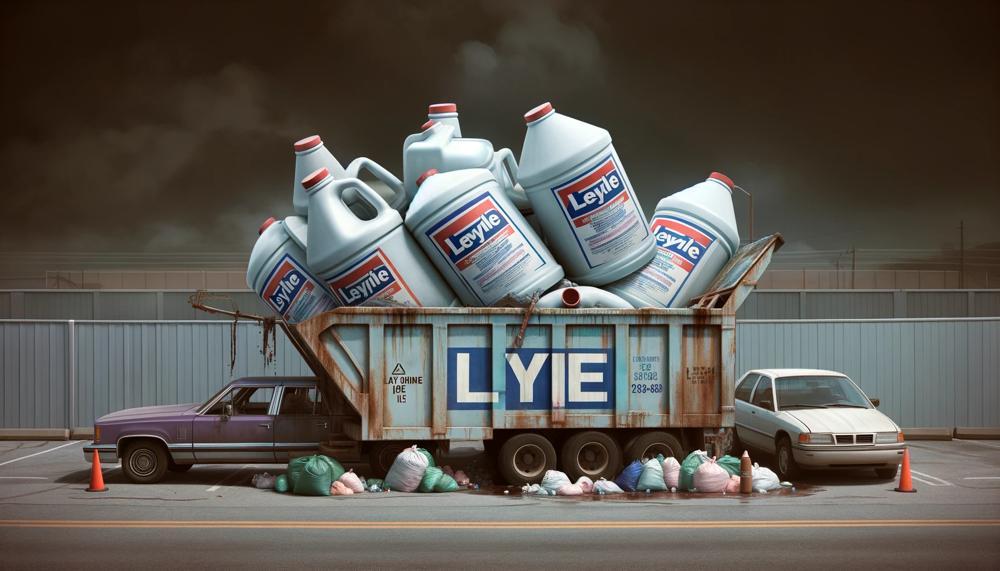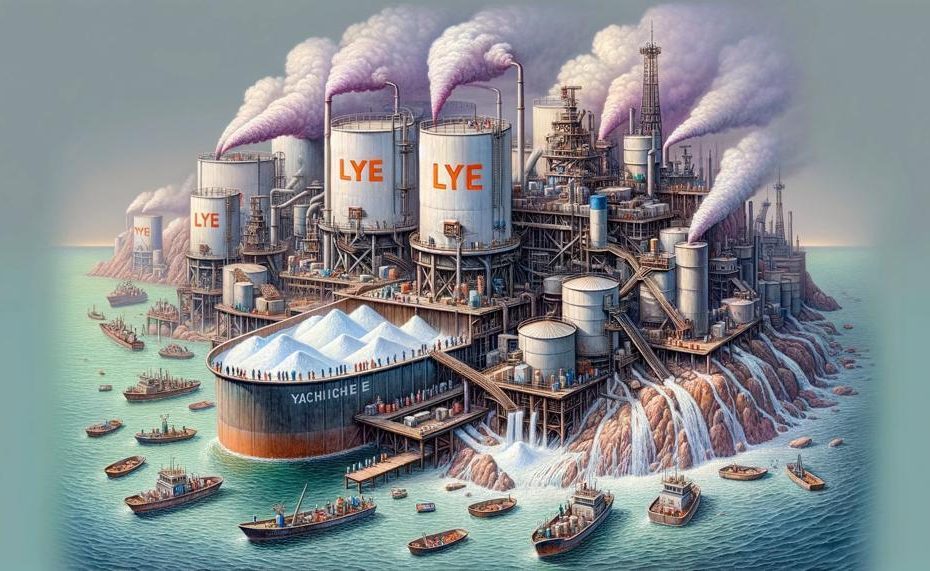When you go into the realm of do-it-yourself chores, particularly those that include soap-making or drain cleaning, you may encounter lye, an intimidating substance. When it comes time to say goodbye, this strong chemical has its own set of difficulties while being very helpful.
It’s important to dispose of lye properly for the sake of the environment and the safety of everyone around us, not only to keep your pipes free. We’re delving deeply into the art and science of properly disposing of lye in this piece.
We’ll keep things casual and conversational, but don’t let that deceive you—we take sustainability and safety seriously.
So, how to dispose of lye properly?
Lye is a hazardous material that should be disposed of according to legal requirements. You should keep it contained and well labeled, and take it to a hazardous waste disposal day operated by your area’s solid waste management agency.
If you’re disposing of lye in solution, you can absorb the liquids in dry sand, earth, or a similar material, and then place it into sealed containers for disposal. For solid lye, you should collect it in a safe manner and then place it into sealed containers for disposal. You should not use water or a wet method, and you should not wash it into the sewer.
Let’s dive in.
Contents
What is Lye?
Lye, often recognized by its chemical name sodium hydroxide, is a potent alkali used in various household and industrial applications, from unclogging drains to crafting homemade soaps.
Due to its highly corrosive nature, handling and disposing of lye demands utmost care to prevent injuries and environmental harm.
Proper Disposal of Lye: A Step-by-Step Guide
To ensure safety and environmental preservation, here’s a meticulous guide on disposing of lye:
| Step | Action | Reason |
| 1 | Don protective gear | Prevents skin burns and eye injuries |
| 2 | Neutralize with vinegar or water | Reduces pH, mitigating corrosiveness |
| 3 | Confirm neutralization | Ensures safety for disposal |
| 4 | Dispose in appropriate facility | Prevents environmental damage |
Why Meticulous Disposal Matters
The significance of handling lye with precision lies in its hazardous potential. Improper disposal can lead to severe burns upon skin contact, respiratory issues if inhaled, and devastating environmental impacts. Ensuring lye is neutralized and disposed of correctly is vital for personal safety and environmental health.
In the realm of safety and environmental stewardship, handling substances like lye isn’t just about following regulations; it’s a commitment to preserving our wellbeing and that of the planet.
Why Is It Important To Dispose Of Lye Correctly?
Lye, a potent player in our world, often steps behind the scenes, unnoticed yet ubiquitous. As sodium hydroxide, its touch is anything but gentle; it’s a brash chemical, bold and unforgiving.
- Aquatic Havoc: Lye’s journey doesn’t end at the drain. Like a rogue, it sneaks into groundwater, rivers, lakes. There, it’s a villain to aquatic life, burning, harming, unapologetically taking lives. Fish, plants, microorganisms – none are spared.
- Soil Sabotage: Lye laughs at balance, scoffing at pH levels. It doesn’t just disrupt; it decimates, leaving soil barren, hostile, a wasteland where life struggles to cling on.
- Air Agony: Even the air isn’t safe. Lye’s disposal can free toxic gases, invisible but insidious, a quiet threat to all who breathe.
Now, why tread the path of careful disposal? It’s not just regulation; it’s a duty, a nod to the fragile harmony of our environment. Here’s a glimpse into the ‘how’ and ‘why’ of proper disposal methods:
| Aspect | Why It Matters | How To Do It Right |
|---|---|---|
| Aquatic Protection | To shield our water’s purity, ensuring it’s a haven, not a hazard. | Don’t let lye chase the waterways. Contain it, follow local disposal guidelines religiously. |
| Soil Preservation | Our soil – a cradle for growth, not a graveyard for chemicals. | Avoid soil contact. Seek hazardous waste facilities; they’re the custodians for such materials. |
| Air Safety | The air we share – let’s keep it clean, not a cocktail of chemicals. | Ensure enclosed, ventilated spaces for handling. Prevent gas release into the open air. |
Remember, this isn’t about ticking boxes or dodging fines. It’s about respect – for our planet, our communities, and the delicate balance we’re all a part of.
Safety Precautions To Take When Handling Lye
When handling lye, it’s vital to adopt rigorous safety measures to thwart skin burns or other injuries.
Gear Up:
- Gloves: Thick, chemical-resistant.
- Goggles: To shield eyes from splashes.
- Mask: Prevents inhalation of fumes.
- Clothing: Long-sleeved shirts, long pants.
- Footwear: Closed, resistant shoes.
- Apron: Preferably rubber, covers torso.
Environment:
- Ventilation: Outdoors or well-aired room.
- Secure Area: Away from children and pets.
Usage:
- Type: Always opt for food-grade lye.
- Equipment: Use materials that resist lye corrosion.
Surface Protection:
- Cover workspaces with resistant materials.
Cleanup and Disposal:
- Thoroughness: Clean spills immediately.
- Disposal: Follow local regulations for chemical waste.
Work in Pairs:
- Buddy System: Ensures immediate assistance.
| Item | Details | Reason |
| Gloves | Chemical-resistant | Prevent skin contact |
| Goggles | Encloses eyes | Block splashes |
| Apron | Rubber material | Body protection |

How To Effectively Dispose Of Lye?
Disposing of lye, also known as sodium hydroxide, necessitates care to prevent harm to both people and the planet. Below are the methods outlined for safe and environmentally friendly disposal of lye.
Neutralization
| Materials Needed | Process | Disposal |
| Vinegar or citric acid | Mix equal parts of lye and the acidic substance | Dispose of the neutralized mixture in the trash or pour down the drain |
Dilution
| Quantity of Lye | Dilution Process | Final Step |
| Small quantities | Add copious amounts of water to the lye | Once thoroughly diluted, it can be safely poured down the drain |
Hazardous Waste Facility
| Storage | Transport | Disposal |
| Seal in a sturdy container | Take to a local hazardous waste disposal facility | Facility will manage safe disposal |
Conclusion
Handling the complex process of disposing of lye involves more than just following the law; it is a sign of deep regard for the environment and community health. Lye is a chemical that is both common and powerful. Proper disposal of it is an essential part of being environmentally conscious. Its incorrect disposal might have a wide range of negative repercussions, from endangering aquatic habitats to lowering soil and air quality.
Adopting proper disposal techniques is an urgent cry to protect our world and its people. This requires a careful process in which lye is neutralized and solidified to turn it from a dangerous material into one that can be handled and safely eliminated. Every action we take, from putting on safety gear to disposing of it at a hazardous waste facility, demonstrates our dedication to sustainability and safety.
The world around us is a reflection of our decisions and behaviors. Through careful neutralization, solidification, and expert consultation for disposal, we fulfill our ethical obligation to future generations as well as legal requirements. We discover harmony with nature in this dance of chemical and moral precision, making sure that our legacy is one of thoughtful preservation and respect rather than one of recklessness.





